 Heavy & Bulky Items
Heavy & Bulky Items"This is an Ergoweb Forum page Archived - Presentations are no longer possible" › › › › › Two-person lifting equipment This theme contains 9 responses, has 7 voices, and was last updated by . What methods are available to occasionally evaluate tasks performed in which a two-person lifting team is used to collect, take a short distance and then place compact, stable but heavy loads? There are several models such as the revised NIOSH model that can estimate the elevator requirements and the descent element for a person who makes the elevator or lower but what is there for both people? Can the NIOSH model be used to estimate the burdens of a person in this case and, if so, how? And then how can you integrate these results to create a usable metric? Any suggestions? Steve Morrissey Ergonomics Consultant Oregon OSHA Hi Steve, based on what you described, with the usual grotto that would need to see the work and learn more details, I suggest you use a biomechanical model and possibly the NIOSH Uprising Equation (and possibly the Mutul Snook and Ciriello/Liberty Tables). The first step is to estimate (or better yet, measure, if you have the equipment to do so) the actual load on your hands during this elevator. A thumb rule for two lifts of person is to estimate that each person, at one point or another during the lift, will bear up to 75% of the weight of the item. Under perfectly coordinated elevation, under perfect lifting conditions, each can support only 50% of the load, but in real conditions, they estimate at least 75% for each. With a biomechanical model, you can now model the posture at the start of the elevator and at the end of the bottom, typically the most extreme points for an elevation task. Such methods will give you estimates of the low back compressive force (at the L5/S1 location of the spine) and the force requirements in each main joint, comparing the values calculated with population standards. You would probably be pushing, if you don't go beyond, the validity limits of NIOSH and Snook/Ciriello tables. However, as long as you know it when you apply and interpret it, you could learn something or reinforce the results you get from biomechanical analysis. I hope this is helpful. Peter's Good Answer by Peter B. He would have thought that a 2-person lift would definitely be beyond the validity limits of NIOSH and Snook. I guess everything's in the interpretation of the results. I have a question for Peter B. You indicate that during an uprising of 2 people in real conditions each person could endure up to 75% of the weight of the object at some point during the lift. This is a much higher percentage than I've seen published. Is there a source for this issue? (I assume we are not talking about extreme elevation scenarios of 2 people, such as moving furniture up or down stairs) Peter Goyert CCPE Senior Ergonomist WorkSafeBC 604 279-7472 Hello Peter, Good questions. I initially thought that NIOSH Equation would not be valid for a two-person lift, but I quickly mentioned the user manual before posting that previous post and I did not find that the two-person lifting or lifting was specifically excluded (although some of the other specific limitations could apply to this task). The Snook and Ciriello/Liberty Mutual Tables are intended for loads with handles located in the average width (body) of the load. Since it is not clear what type of hand you have, if any, are available on the charge that Steve is dealing with, I did not specifically exclude Snook and Ciriello data, but I left it to judge his applicability. And professional judgment is the center of estimating the hazards related to tasks like this. Since we do not have fully validated methods that apply specifically to each conceivable task, we are often doing professional judgments based on the available information. It is sometimes useful to apply several methods (e.g. biomechanical analysis, NIOSH equation, Snook and Ciriello data, in this case), even when none of the evaluation methods are a perfect fit. While we do not interrupt or approve the results, the information we gain can be very useful to understand and control potential hazards. Since we have little information about the details of Steve's tasks, my advice can only be of a general nature. I've used 75% of the total load weight as a conservative estimate for two lifts of person for a long time. I don't have a specific hand reference, but I feel comfortable offering it as a conservative " thumb rule" with unforeseen task conditions, especially when I know little about specific lifting conditions. As mentioned in my original post, I would prefer to see the actual measurements of this task, and I would need to know much more detail before giving specific recommendations. What weight estimates do others use to lift two people or equipment? Is it 75% for a two-person elevator too high? PeterPeter, Your comments on the use of a good professional judgment in estimating the dangers are true. The weight limits of elevation of two people or equipment seem to vary depending on the literature you see. I have a guidance document on the uprising of two people that opens up with..."Most studies show that the lifting capacity is less than the sum of the individual member's capacity by 10-20%." Although the above studies are not mentioned, I read that it means that two people can lift twice one, minus 10-20% of the total burden. This continues to say that "the lifting capacity of the team increases when the workers are equal." Increase in relation to what and how much it is not addressed. There is no information about the details in which these lifts were measured or what type of sample was used. I would also like to hear what others have to say about the issue of the uprising of two people. Peter Goyert Senior Ergonomist WorkSafeBC The Mital (1993) tables briefly examine how to use your data to evaluate the uprising of two people (page 71 of my reference). They recognize the limitation of literature and it seems that there is still a great requirement for professional judgment. Sharon Hi, Steve. The European standard (EN1005-2) and the UK MAC offer procedures for evaluating a two-person lift. The EN basically uses a NIOSH calculation, but with different load constants depending on the user's population (e.g., gender, age). If a lifting team is involved, add an additional multiplier (0.85) to determine the weight for an individual. The British system uses color codes; to increase gravity are green, amber, red, purple. For 2 lifts, the corresponding masses are Greens, 35 kg; Amber 35 85. The MAC provides information on elevators of 3 and 4 people as well. I am not sure of the derivation of the purple code; perhaps to indicate that you are really handy? Steve, On the basis of the research carried out in the 1980s by Karwowski and Mital would have thought that the lifting power of a two-person lifting team would be closer to 90% of the sum of the sum of their individual lifting capacities, provided that these were quite well matched and the load is not a clumsy (i.e., it is easy to grab and it is not so bulky that the workers have to support too much etc.). I have attached a summary of your work that dates from our last discussion on hospital lift equipment, greetings, David McFarlane MAppSc (Ergonomics) Ergonomics, WorkCover NSW Renunciation Any recommendation regarding the use or representation of a particular product brand in this document or any mention of them (whether this appears in the text, illustrations, photographs or in any other way) should not be taken. Details on how we get to the borders for color bands for the management of equipment in MAC are available in a report on its development: Monnington, S.C., Pinder, A.D.J. and Quarrie, C. (2002a). Development of an inspection tool for manual risk assessment., Report No. HSL/2002/30. . In the places involved using an 85% multiplier taken from CEN. The purple areas of MAC are intended to indicate load/frequency combinations that would indicate a very high level of risk of injury because they are acceptable to very few (To be honest, the evidence on the effect of the size of the equipment is contradictory. A great psychophysical study (Meyer, J.P., Macquet, J., Briand, D., Deyris, H., Joguet, M. and Salaun, J.Y. (1988), DI just arrived at this post while looking for information to 2 people elevator max. As reported in the Ergonomic Design for People report on Kodak, Lee and Lee (2001), to determine the safe lifting weight for a team, the acceptable maximum weights of each person must be added and then reduce the total by 12 to 15 percent. The books continue to say that, a general design guideline would restrict the weight of the loads handled by two people to 40kb (85lb) so that most workers can make them safe. Obviously just a source but I thought I'd publish this no matter what. I would love to find additional information about this and will continue my search through literature but I wonder if someone else has additional information from the last post on this subject. Thank you. Frank The forum "General Ergonomics Issues" is closed to new topics and answers. Sustainable Ergonomics Systems Less injury + higher productivity + higher quality 1-888-ERGOWEB (888-374-6932) Silence Silence Copyright ©1995 - 2019 Ergoweb LLC. All rights reserved. Sustainable ergonomics SystemsLess Injuries + Productivity Increase + Higher Quality1-888-ERGOWEB (888-374-6932) Silence 435-214-4150 Silence Silence Silence Silence Silence Copyright ©1995 - 2019 Ergoweb LLC. All rights reserved. Search here
Main menuManual handling - questions and answersManual handling is related to the movement of the elements either by lifting, reducing, loading, pushing or pulling. What is the maximum weight you can lift? When possible, manual lifting should be avoided and mechanical lifting devices such as trucks or trollies should be used whenever possible. There is no legal maximum weight that a person can lift safely. The lifting of any weight can cause injury and much depends on the object being lifted, the environment, the shape of the object, the physical characteristics of the lifter and the distance of the object of the column. An employer must have risk assessments in manual management as required by the Health and Safety at Work Regulation (North Ireland) 2000 and has developed a safe working system to lift as required by the Health and Safety at Work Order (North Ireland) 1978. An employee must be able to ask for the findings of a risk assessment. Risk assessment will define the control measures necessary to protect health and safety. Should an employer consider the uprising and reduction? No, the Manual Management Operations Regulations also apply to objects that are pushed and thrown across a floor. Does my employer have to provide training for manual management? Yes, your employer is obliged to take reasonable measures to reduce the risk of injury to employees who perform manual management operations. In addition, an employer is required to provide information, instruction, training and supervision, as necessary, to protect the health and safety of a person from manual management tasks. Controls The Manual Management Regulation establishes a clear hierarchy of control measures, risk assessments must demonstrate that these measures have been considered. The hierarchy of control measures is as follows: Is there a guide to help employers with manual management evaluations? Yeah. Manual manipulation assessment diagrams (the MAC tool) were developed to help the user identify manual high-risk management activities at the workplace and can be used to assess the risks posed by the lifting, transport and manual handling of equipment. It is designed to help employers understand, interpret and classify the risk level of the various known risk factors associated with manual management activities. It incorporates a numerical score and color encoding system to highlight the manual management tasks of high resistance risk. The MAC tool is available from the following link: Does a two-person lift mean twice what can be lifted? No. Management by two or more people can make possible an operation that is beyond a person's ability or reduce the risk of injury to a single handler. During a lifting operation, the proportion of the load each member of the team will inevitably vary to some extent. This variation is likely to be more pronounced on tilted or uneven terrain. Therefore, the load that a team can handle safely is less than the sum of the loads that individual team members could face when working alone. As an approximate guide the capacity of a two-person team is two-thirds the sum of its individual capacities and for a three-person team the capacity is half the sum of its individual capacities. Teams of more than four are unlikely to work successfully. What is the right lifting technique? There's not one right way to get up. The technique to lift will depend on many things like weight and size of the object. For example, it would be easier to pick up something that is coated and has handles than something clumsily moulded or where the weight is unevenly distributed. The content of any training in good management technique should be adapted to the particular situation or to individual circumstances in which manual handling is carried out. HSE has published guides containing illustrations of good management practices (see resources). Resources Key Legislation Please note that these links are with original legislation, visitors must verify for themselves whether the legislation is in force or whether it has been amended or repealed by subsequent legislation.
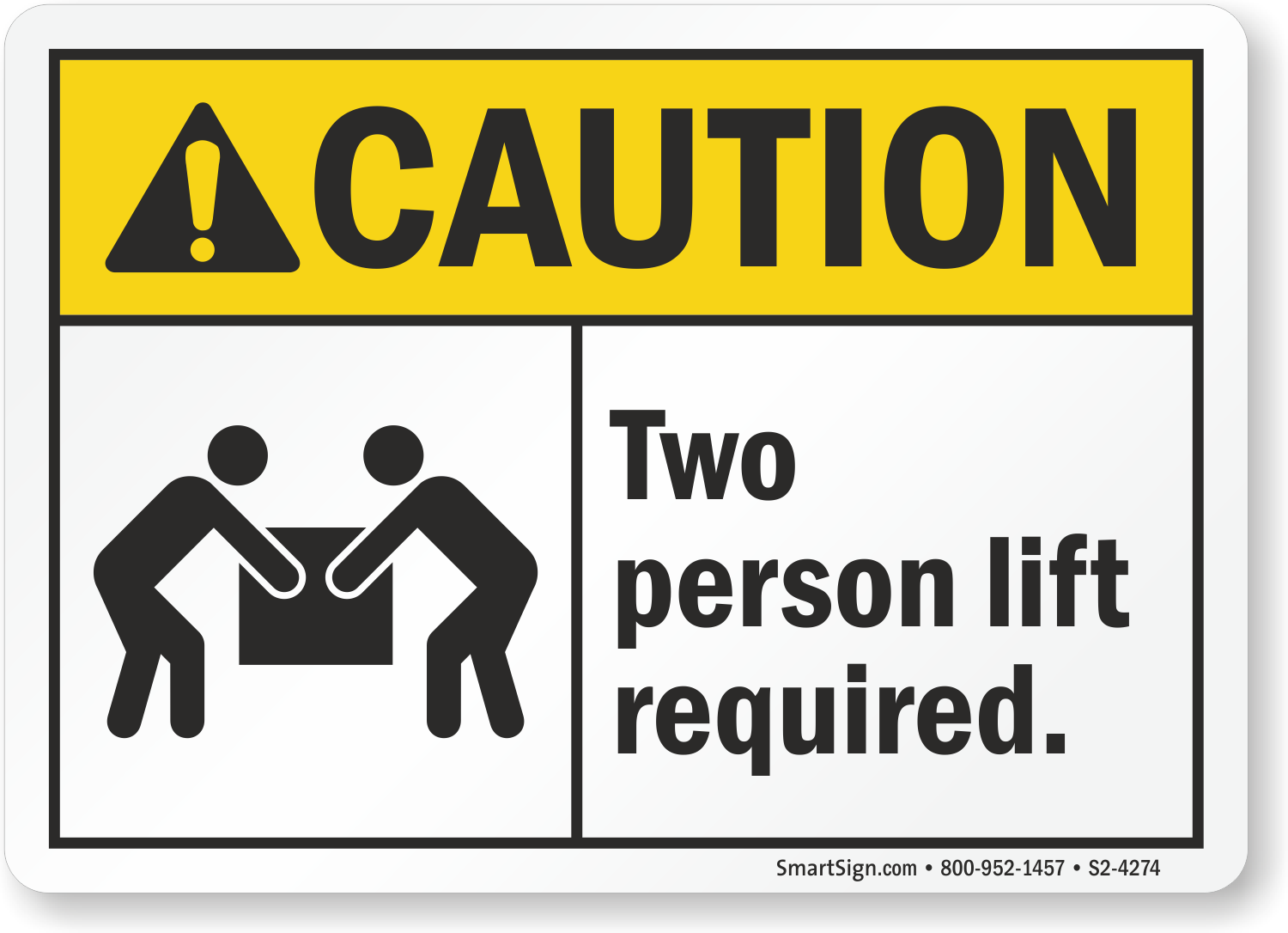
Caution Two Person Lift Required Sign, SKU: S2-4274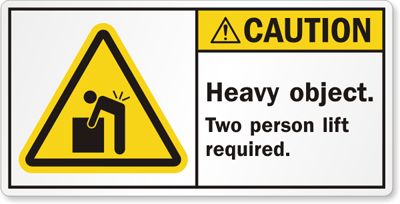
Caution Heavy Object, Two Person Lift Required Label, SKU: LB-0020
Heavy Object Two Person Lift Label J6207 - by SafetySign.com
Vertical Caution Two Person Lift Required OSHA Safety Sign, 14x10 in. Aluminum for Industrial Notices by ComplianceSigns: Amazon.com: Industrial & Scientific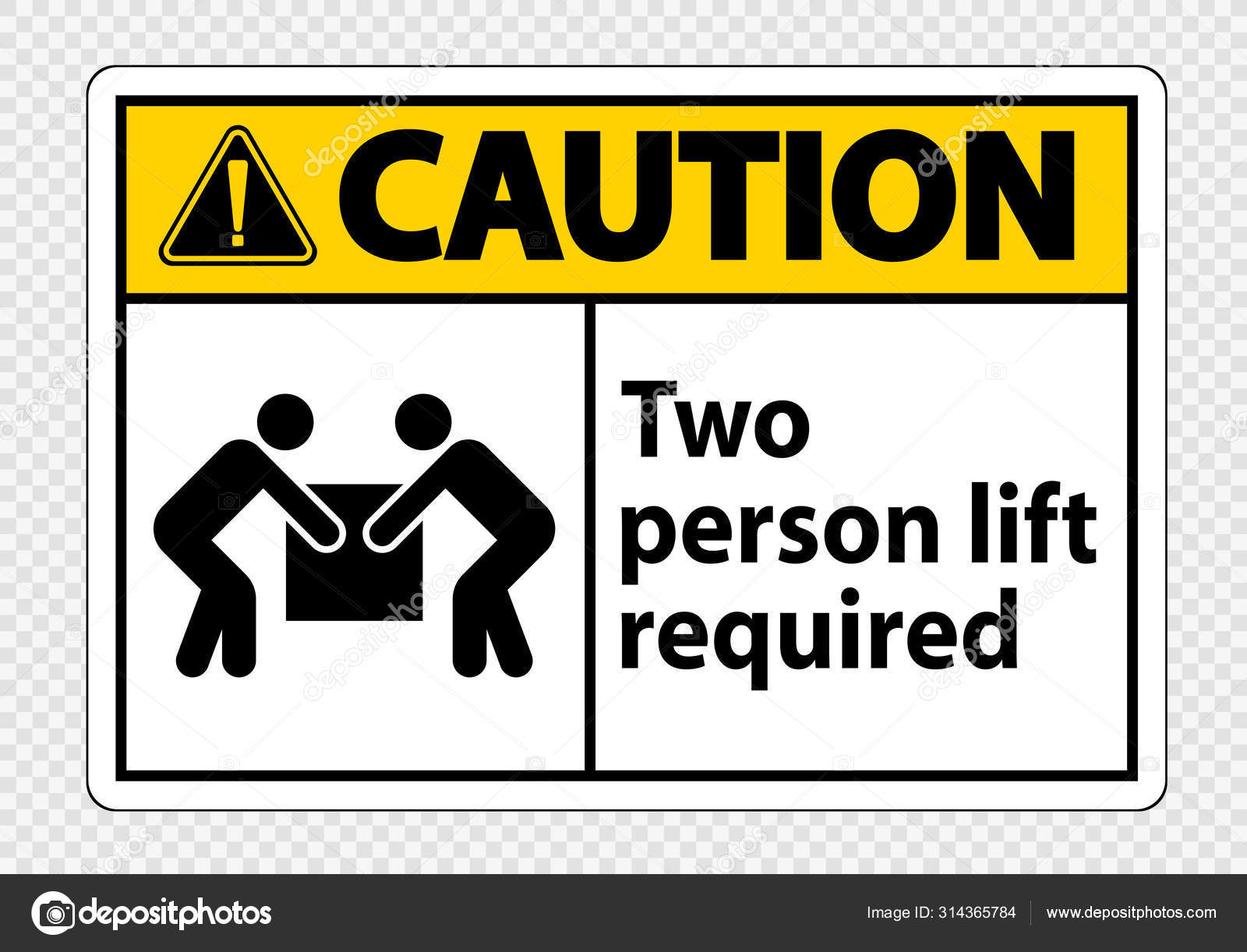
Two person lift required Symbol Sign Isolate on transparent Background,Vector Illustration ⬇ Vector Image by © Seetwo | Vector Stock 314365784
ANSI CAUTION Two Person Lift Required Sign ACE-10030 Lifting
Lift me | The Sterile Eye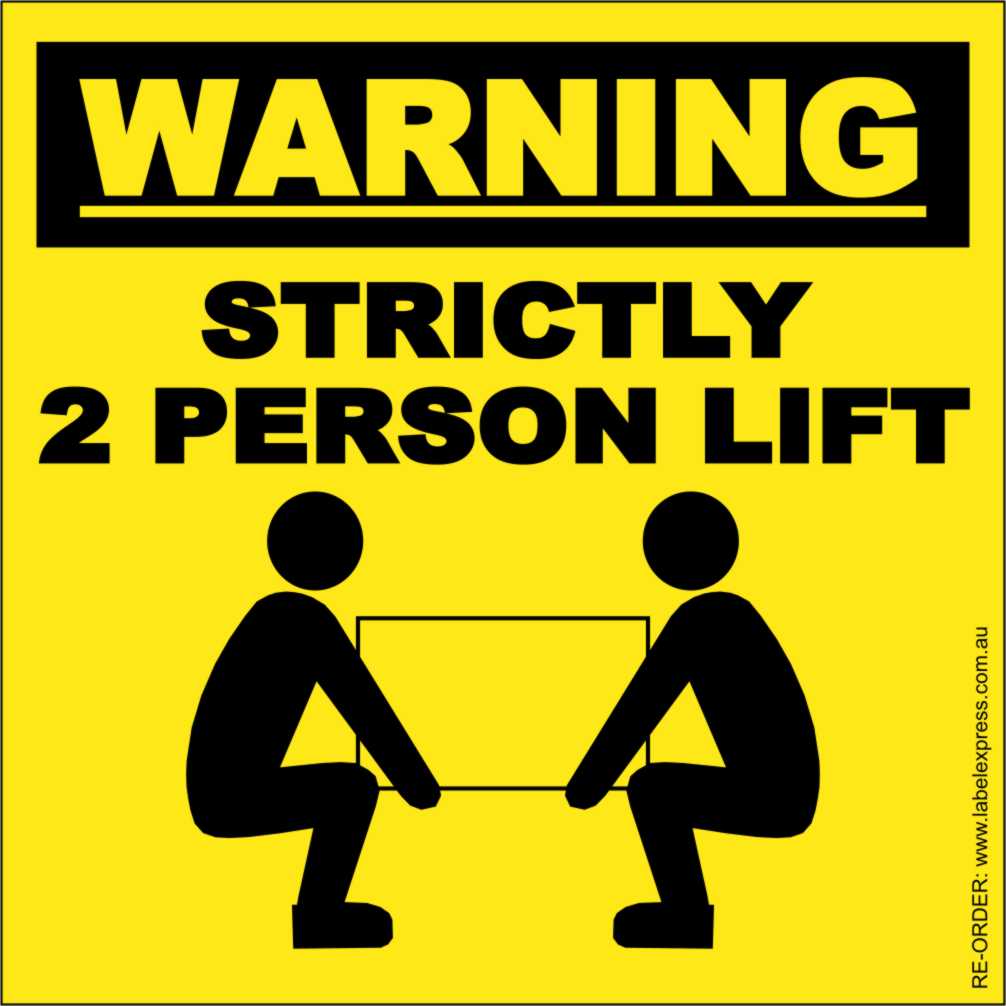
Two Person Lift Label - Pensandpieces
Safety First Use Two Person Lift Symbol Sign, Vector Illustration,.. Royalty Free Cliparts, Vectors, And Stock Illustration. Image 133458377.
Two Person Lift Required Symbol Sign Isolate On Transparent Background,Vector.. Royalty Free Cliparts, Vectors, And Stock Illustration. Image 132362666.
The Right Way to Lif t and Carry
Two Person Lift Label - Pensandpieces
Caution Two Person Lift OSHA Safety Label Decal with Symbol, 5x3.5 in. 4-Pack Vinyl for Industrial Notices by ComplianceSigns: Amazon.com: Industrial & Scientific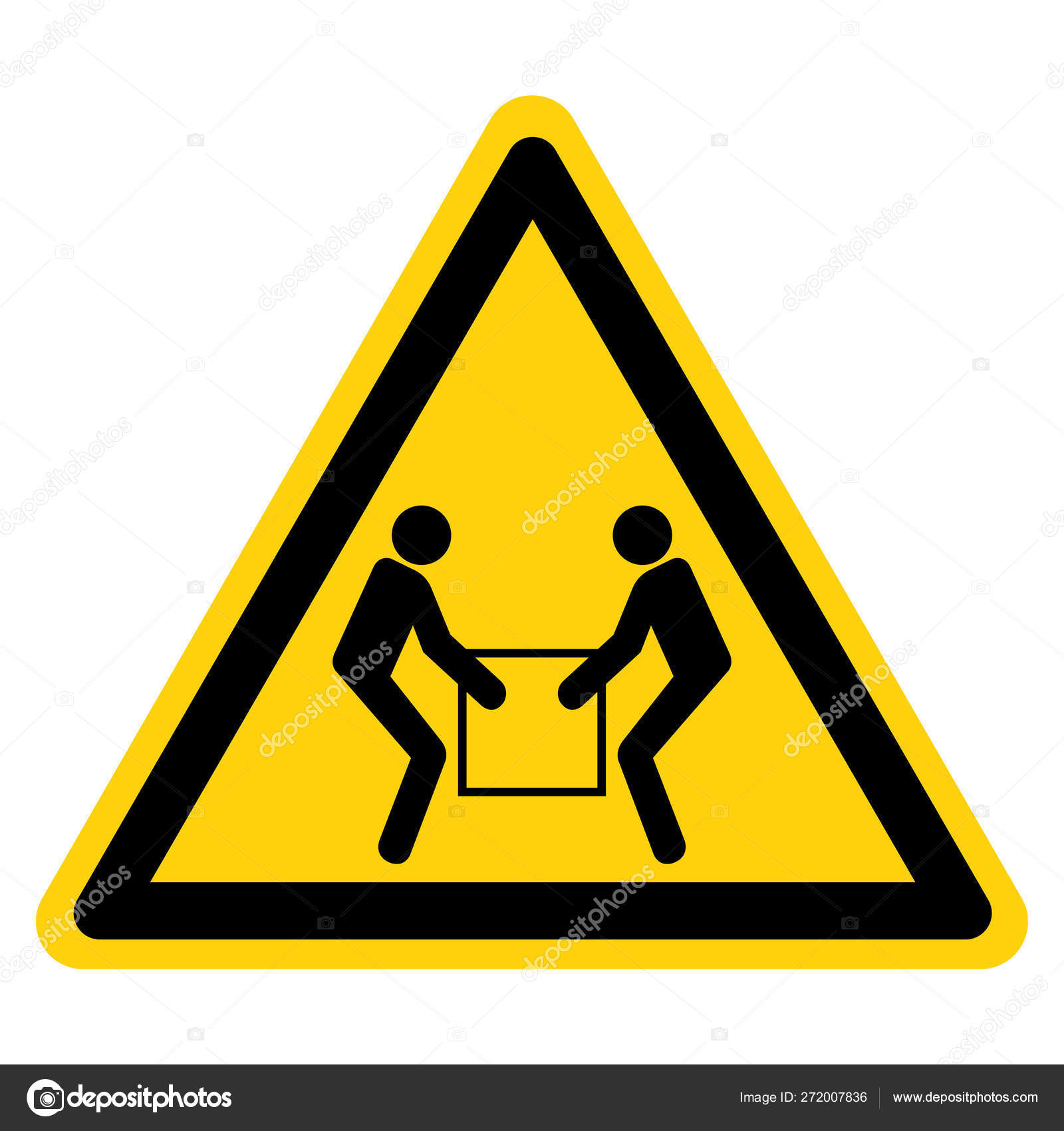
Use Two Person Lift Symbol Sign Isolate On White Background,Vector Illustration ⬇ Vector Image by © Seetwo | Vector Stock 272007836
2 Person Lift 75mm × 75mm – Yellow (660 per roll)
2 Person Lift Sign (Page 1) - Line.17QQ.com
ISO Use Two Person Lift Sign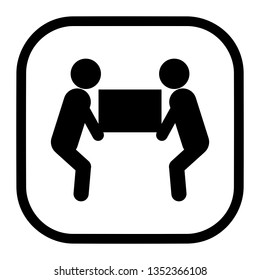
2 Person Lift Icon Stock Vectors, Images & Vector Art | Shutterstock
Two Person Lift Symbol Label LABEL-SYM-46-a Industrial Notices
Two Person Lift
Stop The Spread COVID-19 Max 1 Person To Use Lift with Icon Landscape - Wall Sign | Creative Safety Supply
2 Person Lift Sign (Page 1) - Line.17QQ.com
Use Two Person Lift Symbol Sign Isolate On White Background,Vector.. Royalty Free Cliparts, Vectors, And Stock Illustration. Image 140321797.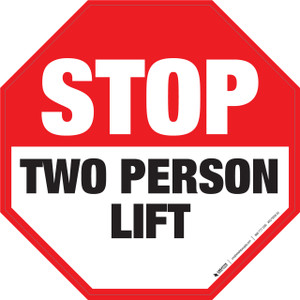
Stop: Two Person Lift - Floor Sign | Creative Safety Supply
WARNING STRICTLY 2 PERSON LIFT DC'S EXE, 1000/roll, 4/ctn
Two Person Lift Symbol Sign Isolate On Transparent Background,Vector Illustration Stock Vector - Illustration of industrial, young: 161450152
2 Person Lift Sign (Page 1) - Line.17QQ.com
Caution Two Person Lift Required ANSI Safety Label Sticker Decal, 5x3.5 in. 100-Pack Vinyl for Industrial Notices by ComplianceSigns: Amazon.com: Industrial & Scientific
Heavy 2 Person Lift Labels | ABL Distribution Pty Ltd
Packaging and labelling in East Anglia and the East Midlands |Bonus Trading 2 Person Lift 148x50mm label
ThinkSystem SR950 - Remove the upper tray filler
The Right Way to Lif t and Carry
Lifting Two Person High Res Stock Images | Shutterstock
Maximum 2 people allowed in the Lift at one time social distancing lift guidance Sign - A4 size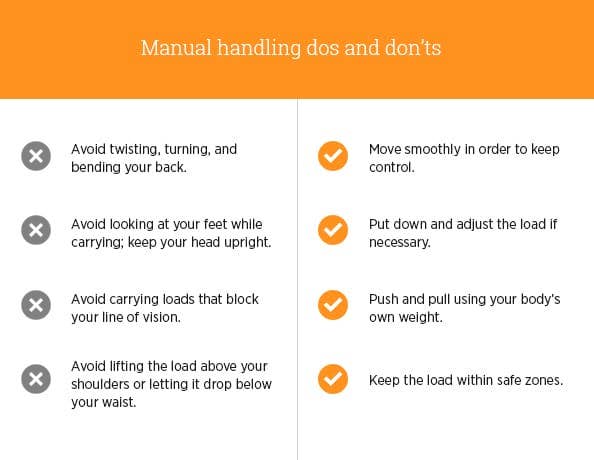
Do you Know Your Manual Handling Weight Limits?
Heavy Object,Two Person Lift Required Sign Isolate On White Background Stock Vector - Illustration of person, heavy: 159526923
Caution/Weight (C12831-03) label
Use Two Person Lift (IS6147-) Label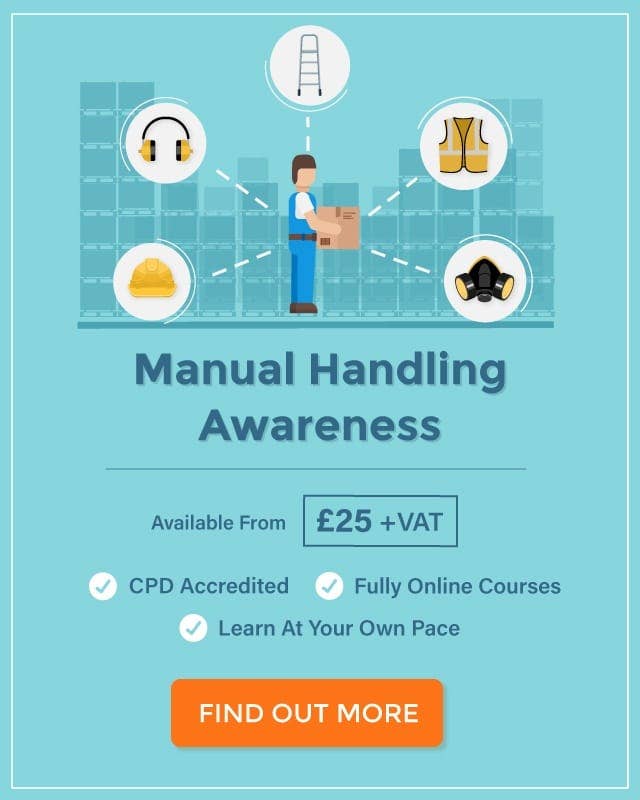
Do you Know Your Manual Handling Weight Limits?
Nielsen Products Shoulder Dolly 3500 Heavy Duty Pro Lift - Padded 2-Person Lifting and Moving System For Professional Movers, Delivery Teams, Industrial and Construction Workers: Amazon.sg: Automotive





































Posting Komentar untuk "2 person lift weight limit"